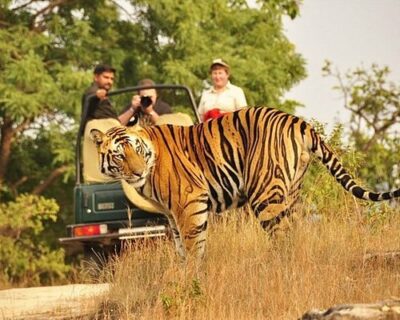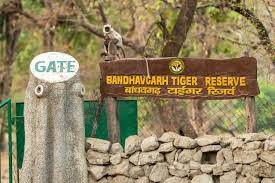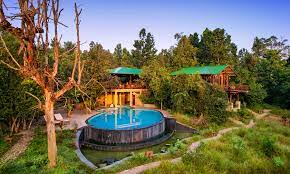Explore Best Wildlife Sanctuary in India & Eco Stays

Table of Contents
India’s wildlife sanctuaries are a testament to the country’s vast biodiversity. With over 500 sanctuaries and 104 national parks, you’re spoilt for choice whether you’re a nature lover, a wildlife enthusiast, or a photography aficionado. From the dense forests of the Great Himalayan National Park in the north to the lush greens of Dandeli Wildlife Sanctuary in the south, India’s wildlife havens are as diverse as they are numerous.
Imagine spotting the majestic Bengal tiger or the elusive Snow Leopard, maybe even catching a glimpse of the rare One-Horned Rhinoceros. Each sanctuary, with its unique ecosystem, promises an adventure that’s both thrilling and serene. Whether you’re navigating the backwaters of Chilika or trekking through the verdant trails of Govind Wildlife Sanctuary, India’s wild realms are waiting to be explored.
Jim Corbett National Par
Stepping into Jim Corbett National Park, you’re entering India’s foremost wildlife sanctuary. Established in 1936, it was initially recognized as Hailey National Park. Post-independence, it witnessed a name change to Ramganga National Park, and finally, in 1956, it garnered its current nomenclature in honour of Jim Corbett—a legendary hunter turned conservationist.
Jim Corbett National Park boasts a rich and diverse ecosystem. As you navigate through the dense forests, you might just catch a glimpse of the Royal Bengal Tiger, which the park is renowned for. Here’s a snapshot of the biodiversity you can expect:
- Royal Bengal Tigers
- Asian Elephants
- Leopards
- Various species of Deer
The park straddles over 520 square kilometres, encompassing hills, marshy depressions, riverine belts, and large lakes. It’s not just the animals that are diverse; the landscape is equally varied, offering you a multisensory experience.
What’s remarkable is Corbett’s commitment to conservation. Your visit supports initiatives designed to preserve the delicate balance of nature. The park operates in zones to minimize human impact, yet still affords visitors a chance to explore its wonders.
Safaris and Excursions
To truly immerse yourself in Jim Corbett’s environment, embark on a safari. The park offers different types of safaris for every adventurer:
- Jeep Safaris
- Canter Safaris
- Elephant Safaris
Each safari navigates through different zones of the park, such as Dhikala, Bijrani, and Jhirna, ensuring you have an unparalleled wildlife sighting experience. Early morning ventures increase your chances of spotting animals in their natural habitats and the serene beauty of the park at dawn is a sight to behold.
Moreover, birdwatchers will find their paradise with over 650 species of resident and migratory birds calling Jim Corbett National Park their home. Make sure to keep your binoculars at the ready to observe the exotic avian life.
Remember, each zone has its distinct features and optimum visiting seasons. Planning your trip according to the zonal specialties maximizes your chances of spotting wildlife. Research, prepare and let the allure of the wild call you to one of India’s most esteemed wildlife sanctuaries.
Sundarbans National Park
When you’re seeking an adventure unlike any other, Sundarbans National Park beckons with a mysterious allure. Spanning over 10,000 square kilometers and shared between India and Bangladesh, this mangrove haven is a UNESCO World Heritage site and a biosphere reserve. It’s known for its unique tiger population—the Royal Bengal Tigers—which have adapted to an aquatic lifestyle amidst the dense mangroves.
Exploring Sundarbans, you’ll navigate a network of tidal waterways, mudflats, and small islands of salt-tolerant mangrove forests. The park’s intricate ecology supports not just the magnificent tigers but also an impressive diversity of birdlife, reptiles like the saltwater crocodile, and other endangered species such as the Irrawaddy dolphin.
Key Highlights of Sundarbans National Park:
- Home to the world’s largest mangrove forest
- A critical tiger habitat for the Royal Bengal Tiger
- Rich in biodiversity with over 260 bird species
Here, safaris come with a twist; boats replace traditional vehicles to offer an immersive experience. Imagine silently cruising through the narrow creeks, every turn promising the chance of a wildlife encounter. You’re not just a spectator; you’re part of the tranquil waters, engrossed in the calls of the wild.
The best times to visit are from November to February, when the weather is cooler and wildlife sightings more frequent. But remember, the park is a tidal area, and access to various parts depends on the tide schedules, so plan accordingly.
Deciding to delve into the Sundarbans means witnessing conservation efforts first-hand. It’s where man and nature coexist in a delicate balance, where you truly grasp the importance of preserving such ecological wonders. To maximize your experience, prioritize spending a few days here, as the sheer scale and unpredictability of wildlife movements demand patience and time.
Kaziranga National Park
Renowned for its One-Horned Rhinoceroses, Kaziranga National Park is a prestige to Assam and a jewel in the crown of India’s wildlife reserves. Covering an area of approximately 430 square kilometers, the park is designated as a UNESCO World Heritage Site due to its remarkable natural environment and conservation efforts.
As you traverse the landscape of Kaziranga, you’ll be navigating through a mosaic of elephant-grass meadows, swampy lagoons, and dense forests. This sanctuary isn’t just about rhinos; it’s a refuge for a multitude of other species. Here’s what you could witness:
- Wild buffaloes charging through wetlands
- Asiatic elephants moving majestically in herds
- Tigers lurking in the shadows of the tall grasses
- Swathes of deer species, including the swamp deer and the spotted deer
Kaziranga’s birdlife is equally impressive. The park boasts a significant population of migratory birds, with winter being the best time for birdwatching. The Brahmaputra River fringing the park also adds a dynamic element to the sanctuary, often bringing seasonal floods which replenish the park’s ecosystems.
Responsible tourism is encouraged here, with safari experiences carefully designed to respect the habitat of the wildlife. Jeep and elephant-back safaris are popular among tourists yearning to get closer to the park’s inhabitants while minimising disturbance.
To ensure you capture the full spectacle of Kaziranga, plan your visit between November and April, outside the monsoon period when the park is often closed due to flooding. The safari lodges and hotels nearby offer a comfortable stay, and can provide you with insights into the best times and zones of the park for wildlife sightings.
The conservation success story of Kaziranga is a testament to India’s dedication to preserving its natural heritage. This park isn’t just a sanctuary for animals; it’s a beacon of hope that showcases what can be achieved with concerted conservation efforts.
Ranthambore National Park
Your journey through India’s wildlife sanctuary landscape would be incomplete without a visit to Ranthambore National Park in Rajasthan. One of the largest and most distinguished national parks in Northern India, Ranthambore is where history and nature intersect, offering spectacular sights of wildlife amid ancient ruins.
Imagine yourself exploring the rugged terrain where royal Bengal tigers roam freely—the park is one of the best locations in India to witness these majestic animals in their natural habitat. Tiger sightings at Ranthambore are not only frequent but also one of the park’s main attractions. This has bolstered Ranthambore’s reputation as a premier destination for wildlife photography and tiger tracking.
The park’s diverse animal population also includes leopards, striped hyenas, sambar deer, and countless bird species, showcasing the rich biodiversity India is known for. But there’s more to Ranthambore than just fauna; the park is dotted with ancient fortresses, temples, and lakes, creating a unique backdrop for your wildlife adventures.
With safaris available at dawn and dusk, you’re encouraged to plan your excursions when animals are most active. The park employs knowledgeable guides and naturalists to enhance your experience, ensuring you not only see the wildlife but also walk away with a deeper understanding of the park’s ecosystem.
Accommodation options around Ranthambore range from luxury resorts to eco-friendly camps, all striving to offer a comfortable stay while maintaining a commitment to conservation.
Best Visit Times:
- October to November (Cooler, post-monsoon period)
- February to March (Mating season for tigers)
Key Points to Remember:
- Book safaris in advance, especially during peak seasons
- Preserve the park’s natural beauty by adhering to responsible tourism practices
- Entrances are at specific times; timing your visit is crucial for an optimum experience
Ranthambore’s blend of historical allure and wildlife wonder creates an unforgettable adventure, showcasing why it holds a special place in India’s ecological and cultural tapestry.
Gir National Park
Nestled in the wilderness of Gujarat, Gir National Park stands as a shining beacon of wildlife conservation. It’s home to the Asiatic lion, a species once on the brink of extinction but now thriving under the park’s protection. With fewer than 600 of these majestic animals left in the wild, a visit to Gir offers a rare opportunity to see these lions in their natural habitat.
Apart from the regal lions, Gir is a sanctuary to a variety of other wildlife species. Here, you’re likely to spot the:
- Agile leopards
- Graceful spotted deer
- Rambling antelopes
- Sneaky hyenas
The park’s terrain, with its deciduous forests, scrublands, and grassy meadows, provides a perfect backdrop for safaris. The Jeep safaris are a popular way to traverse this rugged landscape, allowing you to witness the wild residents amidst the rich biodiversity that Gir has to offer.
Ecotourism is taken seriously in Gir, with efforts made to minimize human impact and sustain the park’s pristine environment. Tourists are expected to respect the delicate balance and abide by the rules to ensure the safety of the wildlife and the continuation of conservation efforts.
The best time to visit Gir is from October to June, the months providing the most comfortable climate for wildlife spotting. Be sure to plan your trip in advance as the park is often a highlight for wildlife enthusiasts and can get quite busy during peak seasons.
Aside from safaris, Gir also offers a cultural experience, with the Maldhari tribe living within the park’s boundaries. Their coexistence with the wildlife adds a unique layer to the sanctuary’s tapestry, showcasing a harmonious balance between man and nature.
As you immerse yourself in the wild charms of Gir National Park, you’ll not only enjoy the thrill of the safari but also contribute to the conservation of some of India’s most endangered species.
Periyar Wildlife Sanctuary
As you journey through India’s majestic wildlife havens, Periyar Wildlife Sanctuary demands attention. Nestled in the Thekkady district of Kerala, this renowned sanctuary is a prime example of nature’s bounty. It’s not just the name Periyar that signifies the importance but also what it entails for biodiversity and ecological balance.
Here’s why Periyar stands out among India’s wildlife sanctuaries:
- Biodiversity: The sanctuary is a vibrant ecosystem, home to a rich variety of flora and fauna.
- Periyar Lake: Gently flowing through the heart of the sanctuary, the lake provides a unique habitat for wildlife and enhances the lush landscape.
- Eco-tourism: Activities in Periyar are designed with conservation in mind, ensuring your visit supports ongoing efforts to protect and sustain the environment.
When exploring the vastness of Periyar, you’re entering a protected area that spans 925 square kilometers. This expanse shelters numerous endangered species, including the elusive Bengal tiger and Indian elephant. The flora here is equally impressive, with a seamless blend of tropical evergreen and moist deciduous forests.
Engage with Nature
Experience the true essence of Periyar by indulging in the safaris that glide you across the serene waters of the lake or through the sanctuary’s dense woods. Enrich your journey by:
- Observing the animal kingdom in its natural habitat while on a boat safari.
- Venturing on guided jungle patrols and nature walks that reveal the unspoken dialogues of the wild.
- Engaging in community-based ecotourism programs that shine a light on local conservation efforts.
Whether you’re an avid birdwatcher or a wildlife photography enthusiast, the sanctuary’s diverse topography provides ample opportunities for you to indulge in your passion. The intricate balance of nature at Periyar prompts reflection on our role in this vast, interconnected ecosystem.
Here’s a quick snapshot of what Periyar Wildlife Sanctuary offers:
| Key Attraction | Description |
|---|---|
| Biodiversity | A refuge for endangered species and rich plant life |
| Eco-tourism | Activities aimed at minimal impact on the environment |
| Educational Value | Learn about conservation and the significance of biodiversity |
Bandhavgarh National Park
Nestled in the heart of India, Madhya Pradesh, Bandhavgarh National Park stands as a testament to India’s commitment to conservation and wildlife. This sanctuary is where you’ll find one of the highest densities of Bengal tigers in the world, making it a premier destination for tiger sightings. As you navigate through the park’s rugged terrains, you’re also likely to encounter a tapestry of other species, from the stealthy leopards to the powerful Indian bison.
Diverse Habitats and Thriving Wildlife
Bandhavgarh’s habitat is a mix of tall grasslands, thick sal forests, and wetlands, creating an environment where diversity flourishes. Here’s an at-a-glance view of the wildlife you might cross paths with:
- Leopards
- Sambar Deer
- Indian Bison (Gaur)
- Nilgai (Blue Bull)
- Over 250 Bird Species
Historical Significance
While the wildlife is the park’s main attraction, Bandhavgarh is also steeped in history. The park houses an ancient fort, believed to be around 2,000 years old, heightening the sense of wonder as you explore. Engravings and relics found within the park hint at a time when human and animal kingdoms intersected more frequently.
Engaging with the Environment
Bandhavgarh offers various safaris to suit your adventurous spirit. Whether you prefer a morning safari to catch the forest’s inhabitants at the start of their day or an evening journey as dusk envelops the land, each experience brings its unique perspective to the fore.
Regular sightings of the park’s majestic tigers are among the many reasons to visit, but it’s the overall ecosystem and historical blend that makes Bandhavgarh a standout example of India’s natural heritage.
Remember, the best time to visit Bandhavgarh National Park is between October and June, when the animals are most active. Plan your trip accordingly and immerse yourself in one of the true pinnacles of Indian wildlife conservation.
Chinnar Wildlife Sanctuary
Immerse yourself in the unmatched natural beauty of the Chinnar Wildlife Sanctuary, a pristine ecosystem nestled within Kerala. Close to the Anamalai Hills, along the border with Tamil Nadu, Chinnar is not just a haven for wildlife but also a repository of medicinal herbs and exotic plants. Its landscape is a testament to the region’s rich biodiversity.
- Discover numerous medicinal herbs.
- Explore exotic plant species found only in this unique eco-zone.
If you’re an adventure enthusiast, embark on wildlife safaris, treks, or hikes that promise to enrich your soul. Experiencing the living forest up close is a thrilling activity that allows for a genuine connection with nature’s untamed beauty. A highlight of your visit will be the Thoovanam Waterfalls, a central marvel within the sanctuary. Witness the cascading waters and the surrounding lush greenery—a perfect backdrop for your serene retreat.
At Chinnar, prepare to capture memories of the region’s vibrant wildlife. You might be lucky to spot:
- Stealthy leopards blending into the scenery.
- Enchanting sambar deer grazing quietly.
- Majestic Indian bison stamping their presence.
Bird lovers will rejoice over the 250 bird species recorded here, a number that showcases the area’s importance as an avian habitat.
When planning your visit, bear in mind the optimal times and essential details for a seamless experience:
| Feature | Details |
|---|---|
| Best Time to Visit | Year-round, but especially accessible between October and June |
| Timings | Dawn to dusk, catering to the best wildlife activities |
| Entry Fees | Vary, check the latest updates for accurate pricing |
Enjoyment in Chinnar isn’t just about observing wildlife; it’s about becoming part of a setting where every element of nature coexists in perfect harmony.
Kanha National Park
Nestled in the heart of India, Kanha National Park stands out as a vibrant tapestry of grasslands and forests. As a conservation success story, it’s the sanctuary that inspired Rudyard Kipling’s ‘The Jungle Book’. Here you’ll find an impressive expanse of wilderness teeming with biodiversity that beckons you to be part of its mystique.
Imagine yourself amid the lush sal and bamboo forests, rolling grasslands and meandering streams. It’s home to one of the largest populations of the endangered Bengal tiger. You won’t want to miss the chance to catch a glimpse of these magnificent cats in their natural habitat.
Aside from the iconic tigers, Kanha’s sprawling acres host a rich variety of fauna, including:
- Barasingha, also known as the Swamp deer
- Sloth bears
- Indian leopards
- Wild dogs (Dholes)
Moreover, an astonishing count of over 300 bird species adds color and melody to the park’s serene landscape. With the park’s efforts in conservation, especially the success in saving the Barasingha from near extinction, you’ll witness firsthand the triumph of dedicated wildlife management.
When planning your safari, you’ll find the park split into four main zones:
- Kisli
- Kanha
- Mukki
- Sarhi
Each offers a unique perspective on the park’s wildlife. Morning and afternoon safaris are available, giving you the flexibility to choose the time that suits you best. These safaris are not just about tiger spotting; they’re about immersing yourself in the overall experience of India’s wondrous ecosystems.
October to June is the best window to visit Kanha; the park remains closed during the monsoon months due to heavy rainfall. So, when you’re charting out your adventure through India’s wildlife sanctuaries, make sure Kanha National Park is on your list for a blend of adventure and tranquility that you’ll remember for a lifetime.
What is the need of Wildlife Sanctuaries?
Diving deeper into India’s rich wildlife heritage, it’s essential to understand the pivotal role wildlife sanctuaries play in conservation. These sanctuaries are crucial for a multitude of reasons, each contributing to a more sustainable future for our planet.
Preservation of Endangered Species
At the heart of wildlife sanctuaries is the mission to safeguard threatened and endangered species. Sanctuary grounds offer a buffer from human encroachment and poaching, providing a safe space for species like snow leopards and red pandas to thrive. The presence of these sanctuaries means species are given a fighting chance amidst extinction threats. Your visit helps support these conservation efforts, allowing you to witness wildlife in its natural habitat, a rare and enriching experience.
Conservation of Natural Habitats
Wildlife sanctuaries contribute significantly to habitat preservation. Dibang Wildlife Sanctuary, nestled in the pristine landscapes of Arunachal Pradesh, exemplifies this with its vast expanses of verdant forests and snow-draped mountains. By protecting such areas, sanctuaries maintain ecological balance and protect biodiversity. The lush territories not only host an array of wildlife but also serve as ecologically critical areas that support life far beyond their borders.
Educational and Research Opportunities
Sanctuaries provide a living laboratory for researchers and biologists eager to study wildlife behavior and ecology. These protected spaces offer you unique insights into the rich array of species like Mishmi Takin and Sclater’s Monal. Educational programs within sanctuaries are instrumental in raising awareness about the importance of wildlife preservation, inspiring the next generation of conservationists.
Economic Support Through Ecotourism
Sanctuaries, including the likes of Dibang, have become vital sources of ecotourism, drawing tens of thousands to revel in India’s natural splendor. This eco-friendly tourism generates income for local communities, fostering economic development that respects the delicate balance of nature.
Sustaining Ecosystem Services
Vital ecosystem services like purification of air and water, pollination of plants, and decomposition of waste are all supported by the rich biodiversity within sanctuaries. The complex networks of life upheld within these protected areas are integral to human well-being, making their preservation all the more crucial.
Remember, the responsibilities to explore responsibly and leave no trace are yours to embrace when visiting these vital natural treasures.
Key Features of Wildlife Sanctuaries in India
Biodiversity
Wildlife sanctuaries in India are renowned for their extraordinary biodiversity. The Western Ghats, home to sanctuaries like Bhadra and Dandeli, acts as a biodiversity hotspot. With topography ranging from verdant hills to dense forests, these sanctuaries host an extensive variety of life forms. You’ll find rare plants, a remarkable array of insects, amphibians, and mammals coexisting within these precious ecosystems. The giant squirrels of the south and the Tibetan antelopes of the north are just the tip of the iceberg when it comes to the distinct species found in these regions.
Endangered Species
The conservation of endangered species is a primary function of India’s wildlife sanctuaries. From the iconic Asiatic lion in the west to the vulnerable red pandas in the east, these sanctuaries provide secure habitats to some of the most threatened species on the planet. Take the Manas National Park in Assam, for instance; it shelters the Assam Roofed Turtle, the Hispid Hare, and the Golden Langur, all of which are on the brink of extinction. By safeguarding these animals, wildlife sanctuaries play a vital role in preventing their disappearance from our world.
Bird Watching
For bird enthusiasts, India’s wildlife sanctuaries are a paradise with an umpteen number of birdwatching opportunities. Teeming with avian life, these sanctuaries provide shelter to both local and migratory birds, creating a thrilling experience for birders. Places like Barda Hills Wildlife Sanctuary see a flurry of bird activity. Whether it’s through the lens of a camera or the naked eye, observing species like the Indian bison and various birds in their natural habitat is a profound reminder of India’s rich natural heritage.
Wildlife Conservation Efforts in India
India’s commitment to wildlife conservation is both multi-faceted and vigorous – key elements for maintaining the country’s rich biodiversity. As you explore India’s best wildlife sanctuaries, it’s worthwhile to understand the backbone of conservation efforts behind these natural havens.
Government Initiatives
The Indian government has laid down a robust framework for wildlife conservation. With laws dating back to the early 1970s, there’s been a secure legal backing for wildlife and habitat protection.
- Wildlife Protection Act, 1972 established to prevent the hunting of animals and to maintain their habitats. This framework marked a pivotal shift from hunting reserves to protection reserves.
- Project Tiger, initiated in 1973, became a flagship endeavor, bolstering tiger populations within specified reserves. Recently, the National Tiger Conservation Authority (NTCA) was constituted in 2005 to strengthen these efforts.
- The inception of Project Elephant in the 1990s aimed to preserve habitats and corridors for India’s revered Asiatic elephants.
- Completing this structure are Protected Area Networks, encompassing national parks and wildlife sanctuaries, which have grown in number, ensuring a wider span of biodiversity is under protection.
With ongoing legislative reinforcement, India ensures the continued existence and well-being of its natural heritage.
NGO Contributions
Non-Governmental Organizations (NGOs) play a significant role in complementing government efforts for conservation in India. Their activities range from on-ground action to policy advocacy and environmental education.
- The Bombay Natural History Society (BNHS), founded in 1883, is one of the oldest and most respected institutions engaged in the conservation and biodiversity research of India.
- Other NGOs like The Wildlife Trust of India (WTI) focus on wildlife crime prevention, conflict resolution, and critical species recovery projects.
- Grassroots organisations collaborate with communities living adjacent to wildlife sanctaries to promote sustainable living and reduce human-animal conflicts.
- Many such bodies organise volunteering and educational programs which serve to spread awareness and engage the public in conservation.
The contributions from NGOs are invaluable, often providing the innovation needed for successful, sustainable conservation models.
Responsible Tourism in Wildlife Sanctuaries
Exploring India’s wildlife sanctuaries is an adventure that requires responsibility and respect for nature’s home. Responsible tourism is paramount to ensure that the sanctuaries remain a haven for the diverse species they protect. When you’re planning your trip, it’s essential to uphold a strict code of conduct and consider eco-friendly accommodation options that have minimal impact on the sensitive ecosystem.
Code of Conduct for Visitors
Your actions within wildlife sanctuaries can have lasting effects on the environment and its inhabitants. To maintain the balance and integrity of these protected areas, adhere to the following guidelines:
- Stay on Designated Paths: Venturing off established trails can disturb wildlife and their habitats. Stick to the paths that have been set for both your safety and the well-being of the sanctuary’s residents.
- Observe Silence: Loud noises can stress animals. You should speak softly and avoid sudden noises to help create a peaceful atmosphere for the wildlife.
- Dispose of Waste Properly: Littering disturbs the ecosystem and can be harmful to animals. Always take your rubbish with you or use designated disposal facilities.
- Respect Wildlife: Maintain a safe distance from animals and never attempt to feed them. Your presence should be as unobtrusive as possible.
- No Flash Photography: The flash from cameras can frighten or disorient animals. Always turn off your flash when capturing the wonders of the sanctuary.
Following these guidelines ensures you leave a positive footprint during your visit and contribute to the sanctuary’s efforts in conservation.
Eco-friendly Accommodation
Choosing where to stay is as important as how you act within the sanctuary. Eco-friendly accommodations offer you the unique opportunity to be close to nature while also supporting practices that are harmonious with the environment.
- Bamboo Huts and Cottages: Local materials like bamboo are often used to construct stylish yet sustainable lodges that offer comfort without taxing the environment. These structures typically have a smaller carbon footprint and blend seamlessly with the surroundings.
- Eco-Lodges: Seek out lodges that prioritise sustainability through water conservation, waste reduction, and using renewable energy sources like solar power.
- Community Homestays: Staying with local communities can enrich your experience. These homestays typically provide insight into local culture and contribute to the local economy while endorsing sustainable practices.
- Luxury Tented Camps: For a more upscale experience, select tented camps that offer luxury without compromising ecological values. They usually operate with a strong emphasis on conservation and community involvement.
When you choose accommodation that aligns with responsible tourism values, you’re playing a role in the larger picture of wildlife preservation and sustainable travel. Always research and select establishments that have established credentials in environmental stewardship.
Conclusion
Discovering India’s wildlife sanctuaries offers an unrivalled opportunity to immerse yourself in some of the planet’s most vibrant ecosystems. By adhering to responsible tourism practices and choosing accommodations that respect the environment, you’re contributing to the preservation of these remarkable habitats. Remember, your visit can have a lasting impact, so let’s ensure it’s a positive one for the incredible species that call these sanctuaries home. Embrace the adventure and cherish the memories you’ll create in India’s wild heartlands.
Frequently Asked Questions
Which state of India has the highest number of wildlife sanctuaries?
The union territory of Andaman and Nicobar Islands boasts the highest number of wildlife sanctuaries in India, with a total of 96 sanctuaries according to the National Wildlife Database.
How many wildlife sanctuaries are there in India?
As of November 2023, India is home to 573 wildlife sanctuaries, covering an area of 123,762.56 km², which equates to 3.76% of the country’s geographical territory, as per the National Wildlife Database Centre.
Which is the largest wildlife sanctuary in India in 2023?
The Rann of Kutch, also known as the Indian Wild Ass Sanctuary, retains its status as the largest wildlife sanctuary in India as of 2023.
Which is the latest wildlife sanctuary in India in 2023?
The newest addition to India’s wildlife conservation areas in 2023 is the combination of Guru Ghasidas National Park and the Tamor Pingla Wildlife Sanctuary, collectively designated as the 54th Tiger Reserve of the country, located in Chhattisgarh.
Which is the most famous wildlife sanctuary in India?
Among the most renowned wildlife sanctuaries in India are:
- Corbett National Park in Uttarakhand
- Periyar Wildlife Sanctuary in Kerala
- Sundarbans National Park in West Bengal
- Kaziranga National Park in Assam
- Ranthambore National Park in Rajasthan
- Kanha National Park in Madhya Pradesh
- Bandipur National Park in Karnataka





